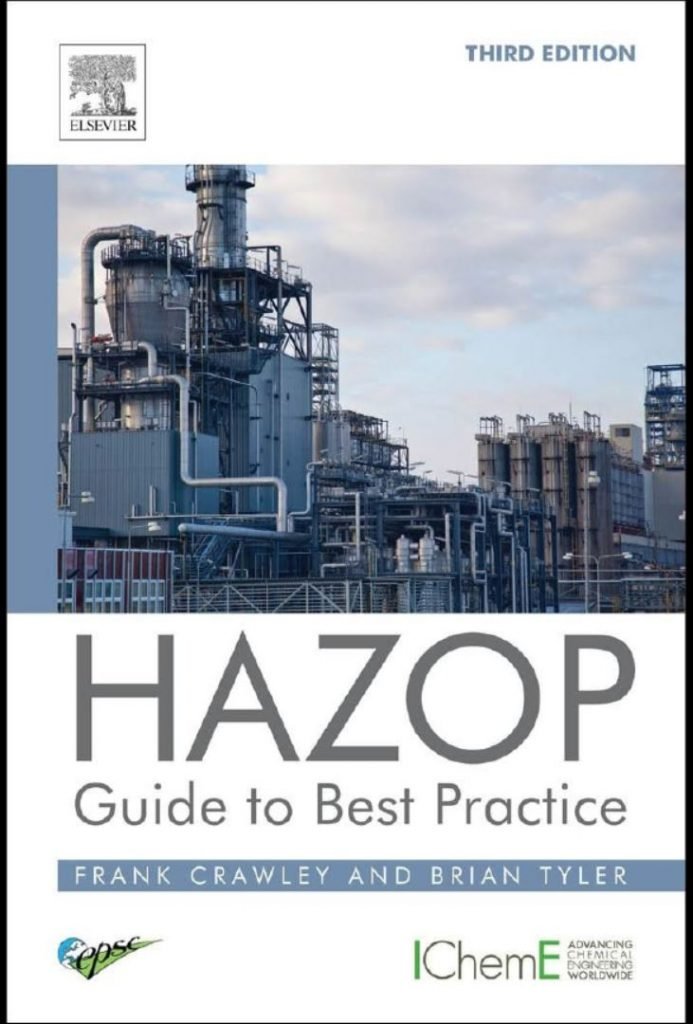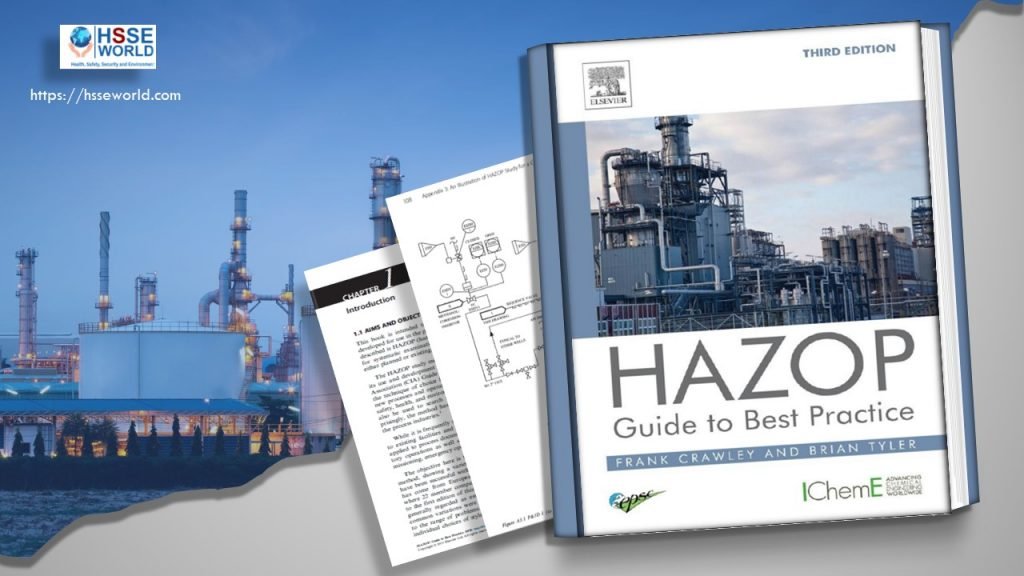E-Books: HAZOP-Guide to Best Practice Third Edition
5 min readThis book is intended to provide guidance on a specific technique developed for use in the process and chemical industries. The technique described is HAZOP (hazard and operability) study, a detailed method for systematic examination of a well-defined process or operation,
either planned or existing.
The HAZOP study method was developed by ICI in the 1960s and its use and development were encouraged by the Chemical Industries Association (CIA) Guide published in 1977. Since then, it has become the technique of choice for many of those involved in the design of new processes and operations. In addition to its power in identifying safety, health, and environmental (SHE) hazards, a HAZOP study can also be used to search for potential operating problems. Not surprisingly, the method has been applied in many ways within the process industries.
While it is frequently used on new facilities, it is now often applied to existing facilities and modifications. It has also been successfully applied to process documentation, pilot plant, and hazardous laboratory operations as well as tasks such as commissioning and decommissioning emergency operations, and incident investigation.
The objective here is to describe and illustrate the HAZOP study method, showing a variety of uses and some of the approaches that have been successful within the process industry. An important input has come from the European Process Safety Centre (EPSC) members where 22 member companies responded in a survey carried out prior to the first edition of this Guide (2000). This identified many features generally regarded as essential to a good study. In addition, many common variations were described.

These variations are in part due to the range of problems encountered within the industry but also reflect individual choices of style. HAZOP study is a versatile technique and good results may be achieved by several different approaches provided the basic principles are followed. It is hoped that this Guide will help maintain a high standard for HAZOP study within the industry, both by raising quality and encouraging flexibility without putting any unnecessary constraints upon its use and development.

The HAZOP study method is well developed and is useful in most applications. There are other methods, however, that may have to be
considered depending on the complexity and hazards of the installation
being constructed and the state of the design. This publication does
not address these methods in detail but their importance is discussed
in Chapter 2. A fuller account is given in the IChemE Guide, Hazard
Identification Methods.
Finally, three illustrations of process industry applications are given
in Appendices 3, 4, and 5. These examples cannot fully represent all the
possible applications and process industries and readers new to HAZOP
study are advised to consult the reference list,3-6 the International
Electrotechnical Commission (IEC) standard,7 or guidelines written
specifically for other industries.
It is hoped that this guide will help people within the process industries, including all those with responsibilities within safety management systems. Although it is primarily written for HAZOP study leaders, scribes, and members, it may also be of use to those involved in training and plant management.
Contents
The Contents of HAZOP-Guide to Best Practice Third Edition
- CHAPTER 1 Introduction
- CHAPTER 2 Process Hazard Studies
- CHAPTER 3 The HAZOP Study Method
- CHAPTER 4 The Detailed HAZOP Study Procedure
- CHAPTER 5 Organizing a HAZOP Study
- CHAPTER 6 Carrying Out a Study
- CHAPTER 7 Recording and Auditing
- CHAPTER 8 Training
- CHAPTER 9 Company Procedures for HAZOP Study
- CHAPTER 10 Advanced Aspects of HAZOP Study
- CHAPTER 11 Specific Applications of HAZOP
- CHAPTER 12 Factors for a Successful HAZOP Study
- APPENDIX 1 The Guideword-First Approach to HAZOP
- APPENDIX 2 The Use of Checklists Within HAZOP Study
- APPENDIX 3 An Illustration of HAZOP Study for Continuous Operation
- APPENDIX 4 An Illustration of HAZOP Study for a Batch Operation
- APPENDIX 5 An Illustration of HAZOP Study for a Procedure
Download the book
HAZOP: Guide to Best Practice
Guidelines to Best Practice for the Process and Chemical Industries
More Downloads
- E-Books: Healthcare Hazard Control & Safety Management
- E-Books: Safety, Health and Working Conditions Training Manual
- E-Books: Energy Efficiency in Water and Wastewater Facilities
- E-Books: Fire Service Features of Buildings and Fire Protection Systems
- E-Books: Evaluation of Fire Safety free download
- E-Books: PPE for Chemical, Biological, and Radiological Hazards free
- E-Books: Changing the Workplace Safety Culture free download
- E-Books: Site Emergency Planning Workbook
- E-Books: Load Restraint Guide
- E-Books: Essential Practices for Creating, Strengthening, and Sustaining Process Safety Culture
- E-Books: System Safety Engineering and Risk Assessment
- E-Books: Permit-Required Confined Spaces
- E-Books: Is it Safe to Enter Confined Space?
- E-Books: 5-Minute Workplace Safety Talks
- E-Books: Safety Culture and High-Risk Environments
- E-Books: Practical Guide to Industrial Safety
- E-Books: Slip, Trip, and Fall Prevention for Healthcare Workers
- E-Books: Health and Safety at Work Key Terms
- E-Books: Fundamentals of Process Safety Engineering
- E-Books: Gas Detection Hand Book
- E-Books: Occupational health and safety management systems ANSI-AIHA-z10-2012
- E-Books: Hot Work on Drums and Tanks
- E-Books: Human Fatigue Risk Management
- E-Books: Guidelines for the provision of facilities and general safety in the construction industry
- E-Books: Handbook of Training in Mine Rescue and Recovery Operations ( 2021)
- E-Books: Code of Practice for the Safe Use of Lifting Equipment – Edition 9 (Nov 2019)
- E-Books: Free Forklift Health and Safety Best Practices Guideline
- E-Books: Handbook of Hazardous Chemical Properties
- E-Books: Human Performance Improvement through Human Error Prevention
- E-Books: Principles Of Fire Risk Assessment In Buildings
- E-Books: Investigation of Occupational Accidents and Diseases
- E-Books: Radiation Protection and Safety in Industrial Radiography
- E-Books: Basic Guide to System Safety, Third Edition
- E-Books: Food Safety Management-A Practical Guide for the Food Industry
- E-Books: Safety identification: Escape and evacuation plan signs- ISO 23601
- E-Books: Safety at Work
- E-Books: The Safety-Critical Systems Handbook 4th edition
- E-Books: Fundamental principles of occupational health and safety
- E-Books: Fire Safety Risk assessment Guide – Sleeping Accommodation
- E-Books: Mental health at work series
- E-Books: Live Fire Training: Principles and Practice
- E-Books: Pre-Startup Safety Review Guide
- E-Books: Fire and Emergency Drill Manual and Building Inspection Guide
- E-Books: Health and Safety: Risk Management 5th edition
- E-Books: Fire Protection systems -Third edition 2021
- E-Books: Fire Safety Logbook templates
- E-Books: From Accidents to Zero
- E-Books: Electric Safety Practice and Standards
- Your steps to chemical safety
- E-Books: Ergonomics and Psychology Developments in Theory and Practice
- E-Books: HAZOPS Should BE fun-The Stream-Based HAZOP
- E-Books: Safety Health and Environmental Auditing
- E-Books: A Quick Guide to Health and Safety
- E-Books: Occupational Ergonomics A Practical Approach
- E-Books: Job Hazard Analysis A Guide for Voluntary Compliance and Beyond
- E-Books: Electrical Safety of Low Voltage Systems



